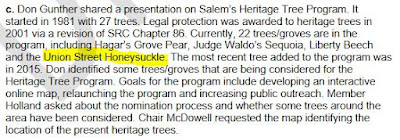With the City announcement of construction starting on the Union Street Bikeway, and then an enthusiastic note over at Salem Bike Vision, it was time to check in on the venerable honeysuckle at Union and Cottage.
 |
| Honeysuckle at Union and Cottage |
 |
| Honeysuckle in 2013 |
To this non-professional eye, it looked like construction was shaving the root zone awfully close. With signage and netting carelessly draped over it, it didn't exactly look like it was getting much special care.
 |
| The root zone |
 |
| Honeysuckle also in 2013 |
It was showing age and a lack of care. Higher up there were several branches broken, and it drooped also like it was in need of water. It had also picked up a lot of moss in the decade since 2013, and it's also possible it's just reaching a natural end.
Maybe it will bounce back, but maybe not.
The tree has been of special interest because it's obviously old, and also because some sources identify it formally as a "Heritage tree."
 |
| Part of a tree walk, April 10th, 2005 |
Back in April of 2005 the paper published a "conversation" from a tree walk, and a leader of the walk said
Well, this is the honeysuckle tree. Both a Marion County and a Salem Heritage tree. Like the description says, normally honeysuckles are just vine-sized. Look at this. It is just amazing how stout that is.
This is Salem's last remaining tree from a program called "Beautify America," a federal program that was existing in the latter part of the 19th century. And again, that's about all that I know about this. It's a remnant from another time.
Over the years I have tried to track down evidence for this "Beautify America" program, and it hasn't turned up. The lore seems to be based on misremembered detail.
If the vine was not simply planted in the parking strip by a resident in front of their home, and was instead part of some more general planting program, it seemed more likely to date from the 1920s and beautification schemes first associated with Elizabeth Lord's mother, Juliet, and the Salem Floral Society. The concepts moved into wider popularity, and were an ingredient in our first zoning scheme of 1926.
 |
| March 14th, 1916 |
More recently, a stray note in the Parks and Recreation Advisory Board mentioned the Honeysuckle in passing.
 |
| SPRAB minutes, December 2022 |
In and of itself the plant is not so grand and, again, it may be reaching the natural end of its life. But if that is true, construction seems to be hastening its end.
Still, if it is a real Heritage Tree, it might tell us something interesting about city planning, about zoning, about shifting understandings of the word "parking" and our autoism, and about the history of parks. Any reasons the tree was designated deserve more attention and discussion, and the tree itself deserves better care while the bikeway, sidewalks, and curb extensions are built. The block has already lost the LaFollette Walnut and several houses. The gravel surface lots are a poor replacement.
Previously see:
- "Prospect of Union Street Bikeway Might Remind us of Heritage Trees Lost and Remaining" (2013)
- "Parking Meant Beauty and Landscaping, not Car Storage, 100 years Ago" (2013)
- "100 Years ago: Roses for City Beautiful Project" (2017)
- "City First Zoned in December 1926, Appealed to City Beautiful Concept" (2020)
Addendum, July 8th
In the packet for the July 13th meeting is some discussion of the Honeysuckle.
 |
| In the packet for July 13th |
They write
PW [public works] Inspectors failed to inform UF [urban forestry] of construction. Basic PW standards were not followed, and we were not advised on this project even though they were aware this was a Heritage Tree.They also repeat what I believe is legend rather than fact:
This large honeysuckle is the last remaining tree from a planting done in the later part of the 19th century as part of a federal beautification project. It is arguably the largest known honeysuckle in Oregon.
I just want to know what is this "federal beautification project."
Addendum, July 30th
Here's a picture of a potential clearance problem.
 |
| Is there enough clearance to pass under? |
The City might have routed the sidewalk segment around the root zone more and this would also give better clearance under the angled "branch" of the Honeysuckle. If the candlestick is 36" tall, that's not six feet over part of the sidewalk. A blind person or person in a scooter might have trouble. Some candlestick styles are 42", and it's possible there's a little less clearance. It seems tight and a sign that this corner and tree wasn't given enough attention during design.


2 comments:
updated with a clip from SPRAB.
Added clip with clearance problem.
Post a Comment